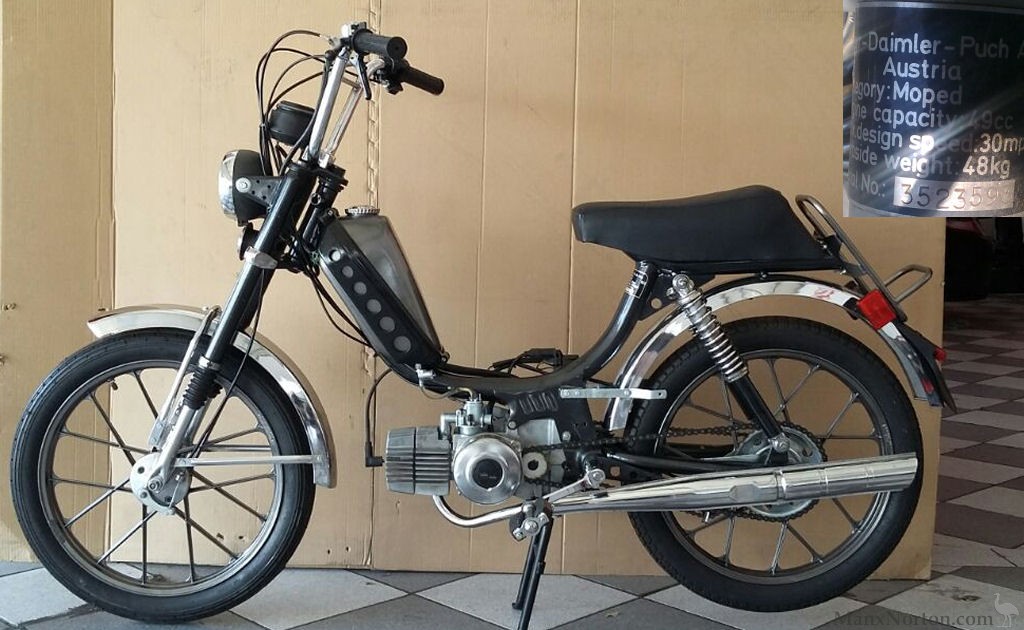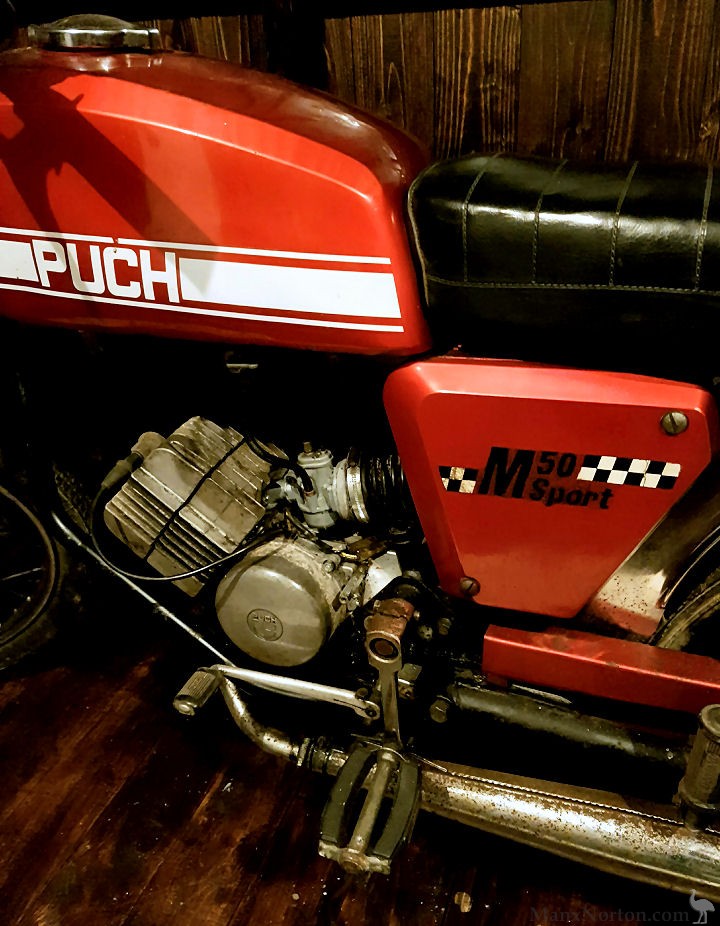Puch Moped Serial Numbers
Dear Puch Owner This is your riding. Moped Riding. Should a need ever exist for parts or service, simply contact your Puch dealer. Serial number location.

If you own a Puch please contribute to the list. This may help us ID bikes by year.
Different models may have the serial number in different locations. On my Trak Pro it is stamped onto a plate riveted onto the BB. Serial Numbers by Year and Model Puch Trak Pro #00044 – Original color: Black (USA) #01168 – Original Owner, John. Purchased in NC, USA Puch Challenger Pro 1982 #K25662 – Original color: Chrome (owner Richard Pennock, UK) Puch Sky Invader 1983 #K83035733 – Original color: Chrome (owner?, UK) Puch Track Invader 1983 #K3832803 – James Chambers Puch Space Invader 1984 #K40321685 – Original color: Chrome (owner?, UK) Puch Turbo II 1983 #K830811206 – Original color: Chrome (owner?, UK) I think K is for Kinesis, 83 the year, 08 the month (August). Puch Freestyler 1986 #T6011004 – Original color: Chrome Puch Super Cruiser 1984 #K41C15573 – Original color: Chrome Puch Unknown Models #k25964 #K830858C3 #T2F2019 – Original color: Chrome #TN395LJ 12 (G0284) Both of these bikes have similar pattern so are most likely same model and one has a Giant code stamped on the dropout as well. Not sure if the top one does. #weird symbol 19 307415 D. Concepts biochemistry rodney boyer pdf.
Shane said, on November 7, 2013 on 10:32 pm I Had a Puch Trac Pro i orderd new and built to specs from the bike store back in 1980 or the early 80’s. It did not have a serial number on it i had to make up my own number for it and they had it stamped on the bottom of the bike. I still remember the number i had them put on it, I would love to get the bike it was stolen a few years after i got it. And i would be glad to buy it back if its out there somewhere serial number on it is 042569 that is my birth date. Thanks for any help or if anybody has a Trac Pro for sale please let me know by email or call me 812 305-0411.
Motorcycle Puch 500 VL with sidecar Felber, built 1937 With the collapse of the empire following the War, the market for automobiles shrank and production was discontinued. However, again in 1919, the new Type XII Alpenwagen was developed. In 1923 the Italian engineer and agent Giovanni Marcellino is said to have been sent by the banks to wind up the Puch factory in Graz. Instead of which, within a few weeks he had settled down to live in the town, designing and then producing a new version of the.
Taking his inspiration from industrial counter-piston engines, the new engine benefited from the improved breathing of the Italian original, to which he added asymmetric port timing. In 1931 Puch won the German Grand Prix with a supercharged split-single, though in subsequent years the split-singles of did better. In 1928 the company merged with into the new Austro-Daimler-Puchwerke. This company in its turn merged in 1934 with Steyr-Werke AG to form the conglomerate. WWII Like all enterprises of its kind, the Puch production plants had to change to arms production during.
The existing capacity was insufficient, therefore a second plant was constructed and opened in 1941 in, Graz. In the three original assembly halls, luxury vehicles for the American market were produced. Is one of the companies known to have benefited from housed in the system during World War II.
Slaves from the camp (who had initially been worked to death in quarries) started to be used in a highly profitable system used by 45 engineering and war-effort companies, and amongst them Puch had an underground factory built at in 1943. Post-War years. Steyr-Puch, 1970-1999 During the period immediately after the war, late 1945 to 1947, the factory was requisitioned and run by the British Army (R.E.M.E.) who used the facilities and what remained of the workforce for the repairing and servicing of British and American military vehicles. In 1949, an assembly cooperation agreement was signed with in.
The 1950s to the mid-1970s saw a sharp increase in production of motorcycles, bicycles and mopeds. Even though Puch was a part of Steyr-Daimler-Puch, it still manufactured products under its own name, as well as for and other companies.
Puch gave up racing in the 1950s and split-single production ended around 1970. 1953: Puch launched two new motorcycles, the and. 1954: The very successful moped was launched. 1957: The legendary small car came on the market.
1958: Production of the Steyr-Puch started. 16,657 vehicles are produced in total and exported into 110 countries. 1966 wins the on a. 1969: The most successful Puch product is launched, moped, 1.8 million of which are built. 1970: The cross-country Steyr-Puch vehicle was launched - production continued until 1999 with over 24,000 built. 1973: Production of the with a Puch engine commenced. 1975: wins the 250 cc world championship for Puch.

1978: Record-setting year, seeing the production of over 270,000 mopeds and motorcycles as well as 350,000 bicycles. 1979: A joint-venture with saw Puch building the in Graz. 1981: Puch has of manufacture a line called the Puch Trak Pro. 1983: A joint-venture with saw the engine being built in Graz. 1983: A joint-venture with Fiat, where Puch designed and built the four-wheel drive mechanics for the.
Vehicles Puch scooters The late 1950s saw strong sales of the two-stroke single, which had three gears shifted from the left. These machines developed a reputation for reliability and were popular for daily commuting, providing good weather protection and ease of use. In this role their moderate performance, with a top speed of around 45 mph, was not a problem. Later models had a 150cc engine and foot-operation, giving better performance of 6 instead of 5 hp but retaining the three gears. Puch mopeds.
Puch MS50 Moped Puch produced the, and MK mopeds, which were popular from the late 1970s to early 1980s. In Austria and the Netherlands, Puch mopeds played a big role in the 1960s. Puch mopeds in Sweden were, and still are, very popular despite the company ceasing production of mopeds in 1985. They were all named after US states, except the Maxi and the Monza. Some of the more popular models were:. VS50 50 cc 2-speed gearbox. The Dakota (VZ 50) 50 cc fan-cooled, 3-speed gearbox.
In fact, the most popular by far. The Florida (MV 50) 50 cc fan-cooled, 3-speed gearbox. The Alabama (DS 50) 50 cc fan-cooled, 3- or 4-speed gearbox The oldest mopeds often had a 50 cc fan-cooled engine with a 1- or 2-speeded gearbox (cric-crac ) and newer mopeds had many different, (always 50cc), engines such as:. Fan-cooled, 3-speed (Dakota, Dakota 3000, Nevada). Fan-cooled, 4-speed (Mexico).
Air-cooled, 3-speed (Arizona, Monza M50, Montana, Monza 3C). Air-cooled, 4-speed (Monza 4speed) Puch BMX Puch began making BMX bikes as early as the 1970s.
Many different models appeared including the Challenger, Invader and Trak Pro. In 1981 they worked with Speed Unlimited in Wayne, New Jersey to manufacture a line of high end BMX race bikes. Speed Unlimited also made bikes for Hutch and their own brand Thruster. The model they made for Puch was the Trak Pro. In 1981 Puch also began sponsoring BMX racers across the United States.
1981 Puch Moped
The green, black and white uniform was soon showing up at BMX tracks across America, especially in the Northeast. There is a collection of Puchs at the BMX Museum - Puch Collection. Puch Maxi. Puch Maxi S Mofa The Maxi is one of Puch's most well known machines along with the Magnum and Newport models. The Puch Maxi is a moped fitted with a single, 50cc,. The engine produced around 2 and could propel the rider at speeds of 28 mph (48 km/h). It was started using the pedals which could be engaged and disengaged from the engine via a starting lever so it could be ridden as a normal bicycle.
Later models did not have pedals, and instead were started with a kick start mechanism. Puch motorcycle marketed as the 'Twingle'.
Puch motorcycle 250 SGS Puch is remembered in the US for importing the SGS 250, the first and last seen there. Marketed by in their catalogue as the 'Twingle', it was styled much like a of the 1950s and 60s. The layout had been popular in Europe between the wars because it improved scavenging, and hence fuel consumption, a feature considered less important in the US. New models after World War II had an internal re-arrangement which improved piston lubrication, reducing wear on the most vulnerable part of the engine, while an early system of pumping the, along with the twin spark-plug ignition, greatly improved day-to-day reliability. Despite the racing heritage and performance potential of the split-single engine, this particular Puch model, with a top speed around 110 km/h (68 mph), was at a disadvantage against the two-strokes that arrived in the late 1960s.
A total of 38,584 of Puch 250 SGS motorcycles were produced between 1953 and 1970. Puch 500. Main article: The Puch 500 was a produced by Steyr-Daimler-Puch in Graz under license from Fiat. Based on the, it was manufactured from 1957 until 1975. Foreign Ventures In 1970 Puch bought a 50% share of Spanish motorcycle and scooter manufacturer Avello located in the city of in, in northern.
During the following years that plant manufactured models with Puch motors and original frames and later built Puch models. Over the years, in spite of good sales, the Spanish venture was losing money and in 1983 Suzuki bought 36% from the Spanish owners so the Spanish venture became a Puch-Suzuki venture. In 1988 Suzuki bought all outstanding shares and became sole owner of the Spanish manufacturer. In the late 1980s, the company was being squeezed out by competition.
In 1987, a massive restructuring of the company led to the end of the production of two-wheelers in Graz. The company's technical know-how was always better than its marketing and commercial success.
The Puch motorcycle company was sold to, maker of the, in 1987 and still produces bikes under the name Puch. When the bicycle division of, which also included was sold to the Swedish group in 1997, Puch became part of. In 2011, Austrian entrepreneur Josef Faber took control of the brand, with the 2012 line of bicycles manufactured by in France., assembler of vehicles and parts, still exists next to the Piaggio division. The so-called ' Einserwerk', the first production plant, shut down in the early 2000s. The historical assembly-hall was declared a protected industrial monument. When Graz became in 2003, a Puch museum was opened in one of the former assembly halls. Puch sold the entire production line of Puch to when production ended in Austria.
It spawned the that sold extremely well in India from 1988 until the end of 2003 when production ended. See also Wikimedia Commons has media related to.
Notes.